Woman Likes Songs
Would you like to hear Awl pal Maria Bustillos talking about the music that interests her? Yes, yes you would.
North Dakota: The Rise of an American Petrostate
by Abe Sauer
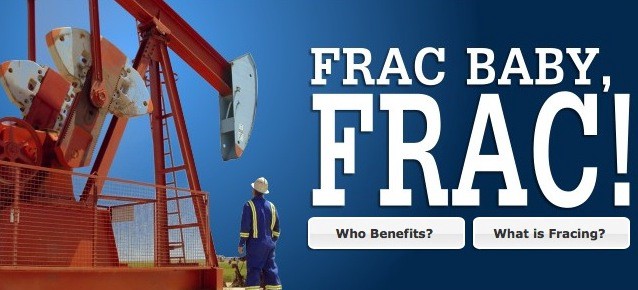
North Dakota is suing Minnesota, alleging the Land of 10,000 Lakes is discriminating against it because it is black. Lignite black. Lignite coal black. The lawsuit contends that the Next Generation Energy Act — a law signed in 2007 by Republican Governor Tim Pawlenty, which limits the amount of power Minnesota utilities can acquire from new fossil-fuel plants — violates the commerce clause of the Constitution. The federal rules, the suit argues, should force Minnesota to buy more of North Dakota’s coal-fired power. The EPA, the suit argues, is the only authority whose regulations should matter.
Most experts have scoffed at the suit. But it’s made all the more bizarre by the fact that participant North Dakota Attorney General Wayne Stenehjem is also currently party to the legal challenge to “Obamacare,” which accuses the feds of attempting to “usurp the general police power reserved to the States.”
The AG’s hypocritical participation in the coal lawsuit exemplifies how North Dakota is slowly becoming a proxy petrostate base of operations for the energy industry to launch a war against federal regulation.
On November 2nd, the North Dakota AG issued a “fact sheet” on the Next Generation Energy Act, which is a gem of Big Energy passive-aggression. It calls the law “purely a symbolic gesture that could only have a negligible impact toward actually achieving the purpose of reducing greenhouse gases on a global scale.” When it mentions global warming, it puts the term quote marks.
The document concludes with a line that is 100-percent “Minnesota Nice”: “As Minnesota seeks to rebuild its economy, it will need energy.” It then goes on to, more of less, call Minnesotans too dumb to know what’s for good for them. And that’s essentially what the lawsuit boils down to: one state telling another state it’s too stupid to know what’s good for it.
In the press, the Attorney General didn’t even bother with the passive-aggression, telling the Star Tribune, “With all respect to regulators in Minnesota, we love our environment more than they do.”
* * *
A recent viral video stitching together time-lapse footage from the International Space Station wowed viewers with a view of earth never seen before. But what everyone missed except one eagle-eyed writer at Midwest Energy News was that the video featured the glowing lights of one “enormous ‘city’ in the middle of nowhere.” That “city,” Ken Paulman discovered, was in fact the fires of natural gas being flared off from thousands of wells in the Bakken oil shale formation. Without a pipeline nearby, 35 percent of all natural gas produced from oil extraction is flared. In a region where average daily temperatures this time of year range from 3 to (a high of) 24 degrees (before wind chill), the sight of a frozen landscape blazing with “Dakota candles” is truly apocalyptic.
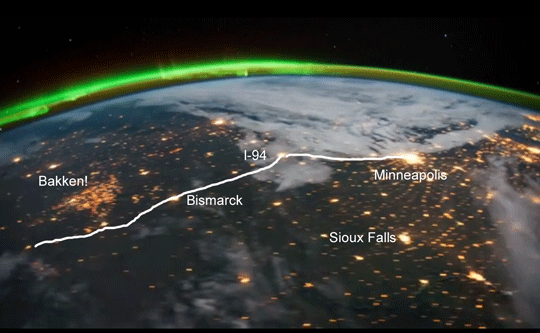
The Bakken formation stretches from Montana through western North Dakota through Saskatchewan. The heart is near Williston, North Dakota, a town that has gone from a population of around 12,000 to 20,000 in just a few years. When a new Motel 6 opened last week, Hallibuton immediately offered to rent the entire thing. By the end of next year, North Dakota will be the nation’s number two oil producer. Every month, the state sets a new record for output. The U.S. Energy Information Administration animated map of Bakken drilling activity between 1985 and 2010 is shocking.
Thanks to advances in a process called horizontal drilling, and the growth of hydraulic fracturing (fracking) as an extraction process, the hard-to-reach oil of the Bakken is now affordable to extract. The absolute best source of exactly how this process works is an industry video.
What the video doesn’t mention is exactly what chemical mix goes into fracking fluid. It doesn’t mention that intentionally, of course. A Clean Water Act Safe Drinking Water Act exemption (called the “Haliburton loophole”) allows fracking fluid recipes to remain undisclosed as a proprietary secret. Kind of like Coca-Cola’s secret recipe, if that secret recipe contained poison and was being injected near drinking water.
Questions about the safety of fracking are widespread, ranging from tapwater that catches fire and mutating farm animals to simple unpleasant odors and the unsightliness of towering gas flares. It remains to be seen how dangerous it is; it’s certainly not good for the earth.
But then, a lot of human activity — maybe most — is not good for the earth. The glowing screen upon which this text currently hovers takes power. Where is that power going to come from? Things Americans like (and like more and more) require power. As for oil, North Dakotan skepticism about a new fuel revolution is well-founded, especially in personal experience. Cell phone batteries struggle to respond on January days in Grand Forks, why would an electric car be any different? (Psst. They aren’t.)
This is to say nothing of how North Dakota’s drive to drag the nation to some semblance of energy independence and better job numbers (those roughnecks making six figures all pay federal income taxes) inspires associated economic development elsewhere. To supply fracking operations, fine silica sand mining is booming in states like Wisconsin, bringing jobs (and associated concerns.) Duluth, Minnesota, is hoping fracking will lead to more work for its port.
This is why fracking will continue and why the Environmental Protection Agency is about to release new guidance for states to use when issuing fracking well permits. Not to get into the boring technicalities, but the rules concern the use of diesel fuel in the fracking slurry, a measure especially necessary when fracking in extremely cold regions. North Dakota, as noted, can be cold. Cue the sky falling.
During his “oops” debate moment, Texas Governor Rick Perry joked that one federal agency he would eliminate was the EPA. When asked if he was joking, the governor said, no, it only needed to “be rebuilt.” But guaranteed, in the fellow oil-state of North Dakota, cheers erupted at the thought.
In 2010, Lynn Helms, the director of the state’s Department of Mineral Resources and the gatekeeper to North Dakota’s oil, said in a weekly address that “the threat of federal regulation of hydraulic fracturing has diminished.” Jump ahead nearly two years and Helms, backed by most of the state’s top politicians, is banging the EPA bogeyman drum. In November, Helms was quoted in the Bismarck Tribune speculating that the EPA was “on track to stop fracking as soon as January.” Naturally, everyone freaked out.
It should be noted that Helms is a former Hess oil executive. That’s the North Dakota equivalent of the Goldman Sachs-U.S. Treasury relationship.
Later, Helms more or less called the reporter a liar. A regional administrator for the EPA penned a follow up piece for the Tribune, writing that Helms’ claim was “grounded in inaccurate information and is misleading.” (The piece was run in the op-ed section.)
Many in North Dakota sought further “assurances” than the word of the EPA. In a recent flood-relief and highway patrol bill, Governor Jack Dalrymple even included a million dollars to pay for a potential lawsuit against the EPA over new fracking regulations.
The industry is seeking even more assurances by turning the entire state of North Dakota into its proxy.
The candidates for national office coming out of North Dakota are beholden to the state’s energy industry hydra. Republican Representative Rick Berg, who replaced the Democrat Earl Pomeroy in 2011, is now running for the Senate seat being vacated by the state’s single remaining federal Democrat, Kent Conrad. Berg regularly speaks out against the EPA and has supported fracking for oil in Teddy Roosevelt National Park as a way to pay for Social Security. After the EPA stated it would not suspend fracking, Rep. Berg stated his distrust, adding, “What we need to do is we need to ensure that the states are going to regulate this.” (Like Minnesota did.)

“What threatens to SHUTDOWN the Bakken,” hollers the website of State Representative Bette Grande, a Republican native of Williston, running herself to replace Rick Berg. There is no question mark and the only two click options available are “Federal Government” and “The EPA.” As if the two were different.
Grande, who now lives in and represents Fargo (330 miles from the fracking in Williston), recently launched the campaign FracBabyFrac.com which won the Orwell Grave-Roll Doublethink Award for 2012, with its motto “Let’s Save the Bakken.” When Grande implores “We can protect the Bakken!” what she means is that we can save the Bakken from government regulation (hint: “The EPA”). She calls the state’s oil industry “over-regulated” and has called the EPA the “Employment Prevention Agency.” In Grande’s view, as with many others who have bought the federal regulations boogeyman story, the EPA wants to shut down oil production because it has a personal grudge against North Dakota. Even among North Dakota’s pro-oil, anti-EPA candidiates (which include most Democrats), Grande stands out in her desire to turn North Dakota into a de-facto petrostate.
It’s noteworthy that State oil director Helms’ position on the EPA is simply that it needs oversight by those elected to Congress. (You know: politicians like Grande and Berg.)
It’s the sort of enthusiasm displayed by Grande that is most worrisome to many North Dakotans. Like any sane, realistic, reasonable people, most residents understand that fracking, and the energy industry as a whole, are an economic necessity for a state whose other industries (such as defense) rely on the exact kind of federal subsidies that are increasingly falling out of favor. But the gung-ho sentiment that an endeavor like fracking is somehow almost “good” for the plains is absurd. It’s an attitude that leaves many wishing for former Governor Art Link, who died last year at the age of 96. Link, who served from 1973 to 1980 in the heart of North Dakota’s first oil and coal boom, is most famous for “When the Landscape is Quiet Again” his passionate 1973 address pleading for a measured approach to energy development.
North Dakotans may be seen as rubes, and many may actually be, but even a rube knows injecting tons of poisonous chemicals into the earth is, at best, only moderately dangerous. This is to say nothing of the ancillary “benefits” the energy boom is bringing to the state, such as massive jumps in crime, $7-a-gallon milk, and elderly residents thrown out of their apartments as rents skyrocket. Massive “man camps” that house rig workers come with the expected crime increase. In the northwest region — the heart of the Bakken boom — the highway patrol just reported a 100% year-over-year jump in road fatalities. Double, in one year. Still, it’s common that pro-energy development interests paint any citizens concerned about these things as pro-EPA radicals who want to send the state back into financial hardship.
* * *
Kris Kitko, the founder of Bakken Watch, a site that’s chronicled some disturbing instances of fracking side effects, tells me the organization has no official stance and its members “range from ‘don’t halt but regulate or slow down’ to ‘halt.’ Personally, she said, “I understand that jobs, etc. are at stake. But so is the land we grow our food on and the water we use to make it grow. I don’t have an answer as to ‘what to do,’ but at the very least, fracking needs to be studied and chemicals need to be disclosed.” She believes closing the “Halliburton Loophole” would at least be a start. Right? Typical hippie nutjob with her ludicrous peace, love and “disclosure” claptrap.
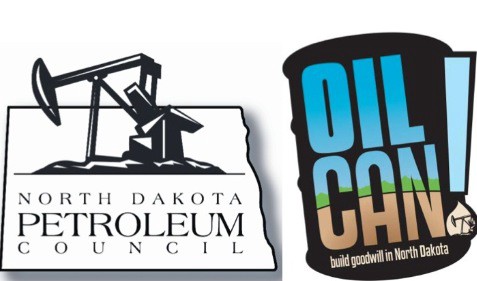
Wary of the increased skepticism of how the energy developers are changing the state and how activists are gaining momentum, industry groups have launched extensive PR efforts such as “Oil Can!” An adorable pun, “Oil Can!” is the propaganda effort of The North Dakota Petroleum Council, whose logo of a massive nodding donkey juicing the entire state could not better explain the organization’s true desire.
There is also the site Fracfocus.org, a “joint project of the Ground Water Protection Council and the Interstate Oil and Gas Compact Commission.” It is also a project of an Oklahoma PR firm which counts among its energy industry portfolio America’s Natural Gas Alliance, the Kansas Oil & Gas Resources Fund and the American Clean Skies Foundation. That last uses the wonderful line “It’s not a drilling rig. It’s a factory.”
Meanwhile, in community after community, oil groups are hosting town halls and sponsoring local picnics and make-nice community events. Truckers who wheel the thousands and thousands of heavy semis through small towns have been given candy to toss to children. The efforts are not all that different than what one would expect in war zone where winning the hearts and minds of the locals was a necessary battle for winning the war.
Just a month ago at an oil conference in Houston, one presenter called pushback against the industry “an insurgency.” He went on to recommend that PR experts in the industry make it a top priority to download the Army and Marine Corps counterinsurgency manual, as “there are a lot of good lessons in there.”
But it’s not just the local populations or helping send fracking-friendly candidates to the halls of government. The oil industry is also rolling out the big guns for a national information campaign to spin North Dakotan oil production as the solution to national energy independence.
An October Wall Street Journal piece on Harold Hamm, the CEO of America’s 14th-largest oil company and the man credited with “discovering” the Bakken, surely rankled some very Christian residents with the title “How North Dakota Became Saudi Arabia.” But the message of a man whose company sits on hundreds of millions of barrels of proven Bakken reserves got a warm reception. The federal government, Hamm said, is “sticking a regulatory boot at our necks.” Hamm goes on to complain that the feds sued his company for killing migratory birds; “It’s not even a rare bird. There’re jillions of them.” Coincidentally, this bird preposterousness is a favorite storyline of one Ms. Bette Grande.
In case the boot of Mr. Hamm’s point wasn’t squarely at the reader’s neck, the Journal added, “It’s hard to disagree with Mr. Hamm’s assessment that Barack Obama has the energy story in America wrong.” The article has been Facebook-shared nearly 7,500 times.
There is a legitimate argument that if America is to gain energy independence and destroy some of itself in the process, why shouldn’t it be a part that most Americans (and many North Dakotans) will never bother visiting? At some time or another, every spiritual North Dakotan will openly wonder of the Bakken, “God could not have intended human beings to live here.” Atheists have no such doubts, of course; evolution confirms to them that humans were not meant to live there.
The Bakken boasts its particular wonders and beauties, like everywhere else. And it’s very easy to not care about the future of the far reaches of more or less unpopulated North Dakota — even within North Dakota. But you don’t have to visit to understand that, as goes North Dakota energy policy, so goes, eventually, the comparatively hospitable state you live in.
Abe Sauer is the author of the book How to be: North Dakota. He is on Twitter. Email him at abesauer @ gmail.com.
Vampire Star Actually Just Kind Of Gassy
“It’s named the CRAP mechanism. I don’t know who came up with the term, but that’s what it is called.”
— Astronomer Jean-Philippe Berger of the European Southern Observatory discusses the CRAP mechanism, in which a star basically farts out its mass on another star. Science, you are so awesome!
Man Bites Man
“A father had his finger bitten off in a brawl with another parent as they waited for their children’s nativity play to begin.”
Early Press Mentions Of The Republican Candidates
Opposition research — political Dumpster diving perfected by Lee Atwater and Roger Stone — has been a part of American politics for nearly 200 years. Your familiarity with Willie Horton, the Rev. Jeremiah Wright and John Edwards’ $400 haircut is a tribute to its irritating persistence as a campaign tool. What follows is oppo research, but we do not aim to inflict damage. In fact, The Awl’s effort, a collection of early media mentions of the Republican candidates (sometimes appearing under their given names), may actually endear these Presidential hopefuls to you. Or am I the only one charmed by 11-year-old zoo booster Newton Gingrich?
MITT ROMNEY
New York Times — February 28, 1960
By the time of this family portrait in the Times, George Romney had been on the cover of Time, having made millions as head of American Motors Corporation. His son, as a classmate would later tell a Boston Globe reporter, was still “tall, skinny, gawky [and] had a bad complexion.”
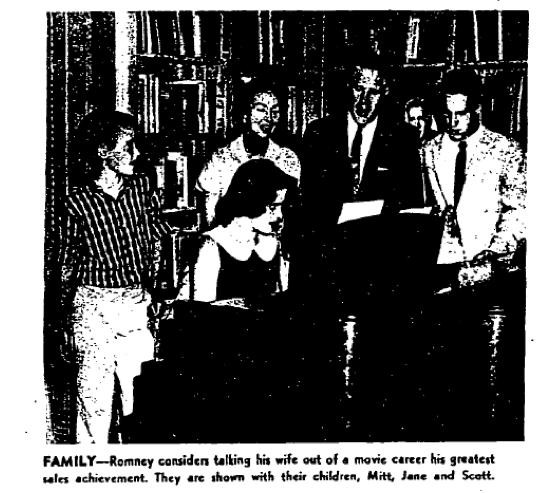
GARY JOHNSON
Albuquerque Journal — December 4, 1976
’76 was a good year for Mr. Johnson: just out of college, he founded Big J Enterprises, a construction firm he’d sell for a profit more than twenty years later, and married Denise Simms. Bride and groom “both of Albuquerque.”
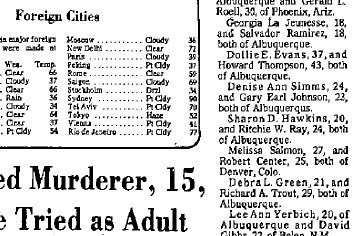
Years later, in 1993, Gary Johnson was a political unknown with a bad haircut, as evidenced in this August 14th The New Mexican profile. He now has an awesome haircut.

MICHELE BACHMANN
Winona Daily News — April 13, 1977
Michele Amble’s push for the legalization of booze on her college campus presaged her fondness for beer companies, from whom she has accepted donations.
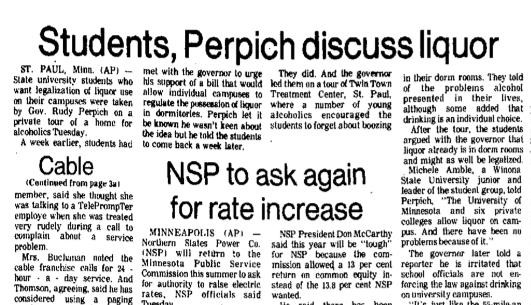
In this AP story, Bachmann, then a junior at Winona State University, was among a group of students pushing for legalization “taken by Gov. Rudy Perpich on a private tour of a home for alcoholics.” The tour evidently did not sway her opinion. Her quote: “The University of Minnesota and six private colleges allow liquor on campus. And there have been no problems because of it.”
RON PAUL
The Brazosport Facts (Texas) — July 11, 1972
Dr. Paul once went to great lengths for a box of Samoas.
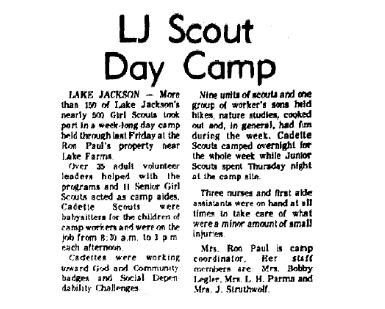
NEWT GINGRICH
Daily Boston Globe — September 1, 1954
Gingrich would eventually become a standard-bearer for conservative values, but in ’54 the little moocher didn’t mind asking for a handout from the mighty producer.
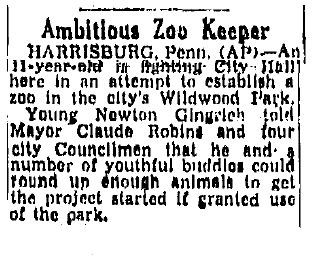
An 11-year-old is fighting City Hall here in an attempt to establish a zoo in the city’s Wildwood Park.
Young Newton Gingrich told Mayor Claude Robins and four city Councilmen that he and an umber of youthful buddies could round up enough animals to get the project started if granted use of the park.
As Gingrich later told CNN, “Early on in life I thought I’d be a paleontologist or a zoo director.” The interest abides: “Yes, I mean, I — when you say to me about really great moments of happiness, it is hanging out at zoos.”
RICK PERRY
Olney Enterprise — September 27, 1984
Perry has long had a reputation as an excellent retail politician. As a then-unelected Democrat, he learned to press the flesh.
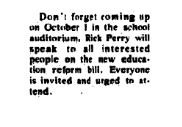
Two years later — as The Houston Chronicle reported on Jan. 29, 1986 — he inadvertently educated a classroom of high-school students.
A state technician says a nude scene attached to the end of a videotaped program on drug abuse was not the fault of the lawmaker who provided the tape to a surprised high school audience.
The scene depicting a nude couple in bed was inadvertently attached to a taped drug program sent by state Rep. Rick Perry, D-Haskell, to the 26 schools in his district.
The discovery prompted Perry to recall all the tapes.
The story as it appeared in The Galveston Daily News.
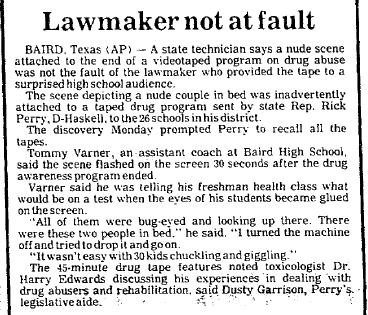
RICK SANTORUM
Associated Press — November 27, 1981
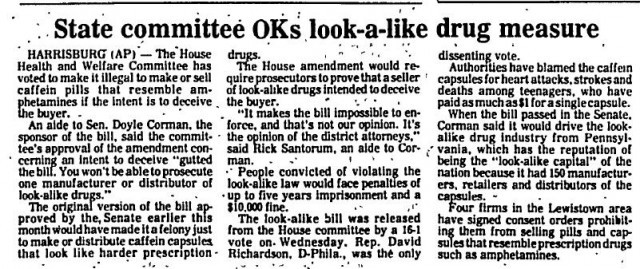
Santorum has famously kept children safe from gays, biology and immigration reform. His opposition to caffeine pills may have been his first crusade. Working as an aide to then Sen. Doyle Colman, Santorum advocated for a bill making it illegal to sell caffeine pills “that resemble amphetamines if the intent is to deceive the buyer.”
JON HUNTSMAN
Deseret News — October 16, 1971
As a new member of the Nixon Administration, Jon Huntsman Sr. introduced the future governor and his brother to the felonious President he would be serving.
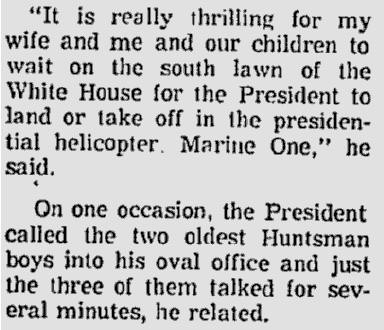
Elon Green writes supply-sider agitprop for ThinkProgress and Alternet.
Our End of the World Contingency Plans
Apparently there was a panel of journalists talking about how they’d cover the end of the world and none of them said “By absolutely not going to work anymore, quite obviously.” Rest assured that, should any sort of cataclysmic event occur, The Awl promises to be the very first website to immediately stop publishing, because, who gives a plucked chicken.
Pay Or Burn
Remember last year when we heard about that house in Tennessee that firefighters refused to put out because its owners had not paid their annual fire subscription fee? And everyone was all, “You’re kidding, right?” Well, they were not kidding then and they are not kidding now. Not burning to the ground is a privilege, not a right. How long before cash-strapped municipalities start going up to random homeowners and saying, “Nice house you got here. Be a shame if it caught fire, wouldn’t it?” I would not be shocked to learn that it is happening already.
Can You Hallucinate Colors?
“Some individuals have the ability to hallucinate colors at will, according to scientists at the University of Hull.”
— I can do this too, but only with black.
The Rock And Roll Hall Of Fame Should Not Exist
“Certainly the body of artists on the museum’s roster represents pop — yes, it’s a certain idea of pop, one with a stamp of Importance that’s defined by values rooted in privileging rock’s ethos over others, but it’s pop nonetheless.”
— Awl pal Maura Johnston is right to sigh and complain about the Rock and Roll Hall of Fame’s inherently awkward and confounding selection process. (And she gets to, because she voted!) I think it’s an institution that should not exist. The fact that Joan Jett didn’t qualify as a first-ballot inductee speaks to why. Even under the problematic organizing principle that has the Beastie Boys making it in over Eric B. & Rakim, who embodies rock’s ethos more than Joan Jett? She’s sold millions of records, she doesn’t care about her reputation, she loves rock n’ roll more famously than anyone else in the world, and she’ll sit in a tiger-striped lounge chair biting the head off of rose after rose after rose after rose, spitting every one back in your face.
Lady Bombs Audition
Lady comic Halle Kiefer, in the latest episode of “Uncastable.” See also: Uncastable: Bobby Finger.
